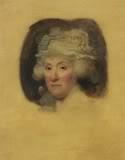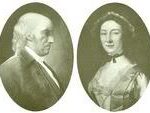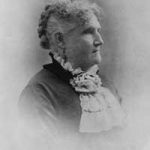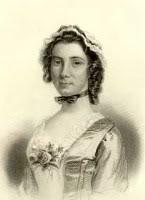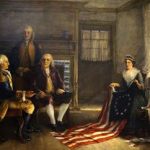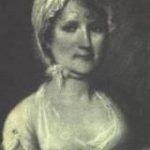Wife of Declaration of Independence Signer Robert Morris
Mary White Morris
Gilbert Stuart, Artist
Mary White was born in 1749. Her parents, Colonel Thomas and Esther White, were described by one historian as “people of the highest character,” who were much respected and socially important members of the Philadelphia community. Her father came to this country from London in early life and settled on the eastern shore of Maryland. After his first wife died, he moved to Philadelphia, and married a widow named Newman. With her he had two children: Mary and her brother William.
Robert Morris was born on January 20, 1734, to Robert Morris, Sr. and Elizebeth Murphet in Liverpool, England. At the age of thirteen, Robert moved to Oxford, Maryland, on the eastern shores of the Chesapeake Bay, where his father was a tobacco factor. The younger Morris was provided a tutor, but he quickly learned everything they had to teach.
His father arranged for Robert to go to Philadelphia, where he stayed with Charles Greenway, a family friend, who arranged for young Robert to become an apprentice to the shipping and banking firm of Philadelphia merchant, Charles Willing. A year later, Robert’s father died after being wounded by the wadding of a ship’s gun that was being fired in his honor, and he was left an orphan at the age of fifteen.
After Willing’s death in 1752, the 18-year-old Morris became the partner of Charles’s son, Thomas Willing. On May 1, 1757, they established the prominent shipping-banking firm of Willing & Morris, which lasted until 1779, and they often collaborated thereafter. Eventually they sent ships to India, China, and the Levant, and the firm’s business of import, export and general agency made it one of the most prosperous in Pennsylvania. As a result, Morris became both wealthy and influential in Philadelphia.
The Stamp Act of 1765 was a tax on all legal documents, yet the lawyers did not act to oppose it. However, the merchants banded together to end what they saw as an unconstitutional tax. Morris began his public career by serving on a local committee of merchants organized to protest the Stamp Act. He mediated between a mass meeting of protesters and the Stamp Tax collector, whose house they threatened to pull down “brick by brick” unless the collector promised not to execute his job. Morris remained loyal to Britain, but he believed that the new laws constituted taxation without representation and violated the colonists’ rights as British citizens. In the end, the stamp tax was lifted.
On March 2, 1769, Mary married Robert Morris, who had gained significant material success at age thirty-five. Together they had seven children, five sons and two daughters. She was described as “elegant, accomplished, and rich, and well qualified to carry the felicity of connubial life to its highest perfection.”
Due to her parents’ status, Mary White Morris was well trained in high-society etiquette by the time of her marriage. She became one of the favorite members of the Republican Court, not only due to her husband’s importance, but also because of her dignified grace and her strength as a hostess, while at the same time caring for her seven children. Rufus Griswold wrote: “She was only twenty, but, by character and training, well adapted to take that social place which her husband’s wealth, political position, and native hospitality assigned to her.”
In 1770, Morris bought an eighty acre farm on the eastern bank of the Schuylkill River where he built a home he named The Hills. This beautiful estate had a greenhouse where he grew oranges and pineapples, two farmhouses, barns, and various other buildings.
Morris in Politics
After the war began at Lexington and Concord, Morris’ company brought in weapons and powder for the militia, while his shipping contacts sent him information about English troop movements. So many supplies came into Morris’ wharf that the Congress posted guards there at night. Robert became increasingly active in the patriot cause. He served with Franklin on the Pennsylvania Committee of Safety, and eventually became its chairman.
Robert Morris was elected to represent Pennsylvania in the Second Continental Congress from 1775 to 1778. In 1775, the Congress contracted with Morris’s company to import arms and ammunition. He was Chairman of the Secret Committee where he devised a system to smuggle war supplies from France a year before Independence was declared. Morris also used his extensive international trading contacts as a spy network and gathered intelligence on British troop movements.
In Congress, Morris served with John Adams on the committee that wrote the Model Treaty, which incorporated his long held belief in Free Trade. It was an outgrowth of his trading system, and acted as the basis for the Treaty with France. He served on the Marine and Maritime Committees, and sold his best ship, The Black Prince, to the Continental Congress. It became the USS Alfred, the first ship in the Continental Navy. John Barry, one of his employees, became its Captain.
On July 1, 1776, Morris voted against the Congressional motion for independence, because he thought Americans were not ready for self-rule and he feared anarchy would result. The following day, Morris and John Dickinson declined to vote, allowing the Pennsylvania delegation to vote for independence. Yet on August 2, Robert Morris signed the Declaration of Independence, saying, “I am not one of those politicians that run testy when my own plans are not adopted. I think it is the duty of a good citizen to follow when he cannot lead.”
![]()
Robert Morris Signature
On the Declaration of Independence
While other Pennsylvanians lost their Congressional seats for voting against the Declaration, Morris was immune because his services were too valuable to give up at a time when a new government was taking shape. In a letter explaining his actions, Morris proclaimed that “it was an improper time” for America to try to separate itself from Great Britain.
When Congress fled to Baltimore as the British were approaching in December 1776, Morris moved his family to the country, then returned to Philadelphia. Almost in despair, George Washington wrote to him, and informed him that it would require a considerable sum of money to make any successful movement whatever. Morris gave $100,000 from his own funds to pay Washington’s troops, which helped keep the Army together just before the battles of Trenton and Princeton. Morris and Washington became great friends, and a strong and long-lasting friendship between Martha Washington and Mary Morris soon followed.
Morris’ wealth increased, thanks to privateers who seized the cargo of English ships during the war. He owned an interest in many privateer ships, and also helped to sell off the English spoils as they came into port. He used money gained from that pursuit to buy shares in a variety of ships that waged an economic war on Britain.
While he was seen as profiting handsomely from this activity, he wrote a friend that he lost over 150 ships during the war and so came out “about even.” In fact, he had lost one of the largest private navies in the world during the Revolutionary War, which he had acquired prior to the war, but he never asked for reimbursement.
Immediately after leaving the Congress, Morris served two more terms in the state legislature, from 1778 to 1781. During this time, Thomas Paine, Henry Laurens, and others accused him and his firm of making profits from private business ventures that were made in the name of the government. A congressional committee acquitted Morris and his firm on charges of engaging in improper financial transactions in 1779, but his reputation was damaged after this incident.
Morris and his allies supplied war materials to the troops when the state failed to act. Pennsylvania went bankrupt in 1780, and the state ultimately called on Morris to restore the economy. He did so by opening the ports to trade, and allowing the market to set the value of goods and the currency.
Morris risked his own finances to help strengthen Washington’s army during important battles, and his services became more and more valuable. As a member of the committee of ways and means, he worked hard, and gave the government the full benefit of his credit. In 1779, he supplied General Nathanael Green with munitions. Without Morris’ help, the military campaigns of 1780 would have been impossible; he raised $1,400,000 to assist Washington in the movement that resulted in the capture of Yorktown.
In February 1781, he was unanimously elected superintendent of finance. As superintendent of finance, he slashed all governmental and military expenditures, personally purchased army and navy supplies, strengthened accounting procedures, urged the states to fulfill quotas of money and supplies, and when necessary used his personal credit by issuing notes over his own signature or borrowing from friends.
Superintendent of Finance
In 1781, the United States was in a crisis. The British controlled the coast line, two major cities, and the western frontier. The treasury was in debt by $25 million and public credit had collapsed. Morris made good on the US’s debt from his own funds.
With the failure of their own policies staring them in the face, Congress changed from the committee systems they had used for years, and created the first executive offices in American history. Robert Morris held two of them – Finance and Marine. While his detractors worried he was gaining “dictatorial powers,” he was granted what we would call today “executive authority.”
In a unanimous vote, Congress appointed Morris Superintendent of Finance of the United States, a position he held from 1781 to 1784. To defend himself from his critics, Morris insisted that Congress allow him to continue his profitable private endeavors while serving in a related public office. In practice, he was not active in private business during his term and acted as a silent partner in various companies.
Three days after becoming Superintendent of Finance, Morris proposed the establishment of a national bank. This led to the creation of the first financial institution chartered by the United States, the Bank of North America, which was funded in part by a significant loan Morris had obtained from France. The initial role of the bank was to finance the war against Britain. The bank was incorporated by Congress December 31, 1781, and went into operation January 7, 1782, with a capital of $400,000.
As Superintendent of Finance, Robert Morris instituted several reforms, including cutting government spending by using competitive bidding for contracts, tightening accounting procedures, and demanding the federal government’s full share of support (money and supplies) from the States. He also proposed to make the American currency a decimal currency, an idea that was unique at the time. In all his work, he was assisted by his friend and assistant Gouverneur Morris (no relation).
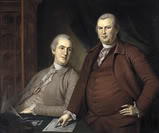
Robert Morris
With Gouverneur Morris (left)
Charles Willson Peale, Artist, 1783
In 1781, Morris took an active role in getting General Washington from New York State to Yorktown, Virginia, and was in Washington’s camp the day the action was initiated. He acted as quartermaster for the trip and supplied over $1,400,000 in his own credit to move the Army. After Yorktown, Morris noted the war had changed from a war of bullets to a war of finances.
At times, Morris took out loans from friends and risked his own credit by issuing notes on his own signature to purchase military supplies; in 1783, he issued $14,900,000 of his own notes to pay the soldiers of the Continental Army. He did this during the same year that New Hampshire contributed only $3000 worth of beef toward the war effort, and all the states combined contributed less than $800,000. This extensive use of his personal credit strained his personal fortune.
He proposed a national economic system in a document called On Public Credit. On January 15, 1782, Morris drafted a proposal that he later presented to the Continental Congress to recommend the establishment of a national mint and to make the American money a decimal currency, an idea that was unique at the time. The United States Mint was not established until 1792, after further proposals by Alexander Hamilton.
Later Career
In 1787, Morris was elected to the Constitutional Convention, along with his good friend Gouverneur Morris. Although Robert Morris said little at the Convention, his former assistant, Gouverneur, and his lawyer, James Wilson, were two of the three most talkative men there. Morris’ only significant role of record during the Convention was to nominate his friend George Washington as its president. Robert Morris signed the United States Constitution for Pennsylvania.
When the new government was organized, President Washington wanted to appoint Morris Secretary of the Treasury in 1789, but Morris declined, suggesting instead Alexander Hamilton, who was a supporter of his policies. From 1789 to 1795, Morris served as a member of the first U.S. Senate.
Morris was on 41 Senatorial committees and reported for many of them. He focused on using his position in the Legislature to support the Federalist economic program, which included internal improvements like canals and lighthouses to aid commerce. As Senator, he generally supported the Federalist party and backed Hamilton’s economic proposals. Hamilton’s proposals were, in actuality, a rework of Morris’ report, On Public Credit, submitted some ten years earlier.
Robert and Mary Morris donated their Philadelphia mansion to the fledgling federal government for use as the President’s house during the ten years that Philadelphia was the national capital. While Washington, DC, was under construction, Presidents Washington and Adams used it as their residence. In 1794, Morris began building a new house on Chestnut Street in Philadelphia.
Later Years
Morris left public office in 1795, and in partnership with Gouverneur Morris, tried to re-establish his personal wealth. He began new business ventures, including a canal company that became one of the first organizations to advance improvements in Pennsylvania. He had a steam engine company, the first iron rolling mill in America, and his ice house was the model for the one Washington put in at Mount Vernon.
Robert Morris became arguably the largest private property owner in the history of the United States. Since the war, Morris had gradually disposed of his mercantile and banking interests and engaged extensively in western land speculation. At one time or another, he owned nearly the entire western half of New York state, two million acres in Georgia and about one million each in Pennsylvania, Virginia, and South Carolina. He also invested heavily in the District of Columbia.
The slow development of his properties, the failure of a London bank in which he had funds invested, the erection of a palatial residence in Philadelphia, and the dishonesty of one of his partners, finally forced Morris into bankruptcy. Morris owned all that land but didn’t have enough hard money to pay off his creditors.
Morris’ economic failure reduced the fortunes of many other prominent Federalists who had invested in his ventures. His political adversaries used his bankruptcy to gain political power in Pennsylvania.
Robert Morris was indebted to many people, and his creditors began to pursue him. He fled to his country estate, known as The Hills, leaving an unfinished mansion in Philadelphia which would famously become known as Morris’ Folly. It was sold at auction in 1799. At one point, he contemplated suicide before realizing it would be terrible for his wife and children.
Morris turned himself in on February 14, 1798, and was eventually sent to debtor’s prison in Philadelphia, where he remained in custody for three and a half years. But his true friends did not desert him. George Washington still supported Morris and kept in touch with him in prison. Thomas Jefferson considered giving Morris a spot in his cabinet if he got out of prison in time.
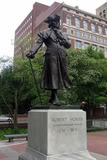
Robert Morris Monument
Independence National Historical Park
Philadelphia, Pennsylvania
This statue of Robert Morris by sculptor Paul Wayland Bartlett was cast in 1925. It depicts Morris making his way through the snow during his mission to raise funds for Washington’s troops at Valley Forge.
During Robert’s financial troubles, Mary was a loving and supportive wife. Through certain interests in the Holland Land Company, bequeathed to her by Gouverneur Morris, she obtained from that corporation a life annuity of $2,000 before she would sign certain papers to which her signature was indispensable.
During her husband’s imprisonment, Mary received an autographed letter from the President and First Lady, George and Martha Washington. They urged Mary to pay them a visit at Mount Vernon, and to make as long a stay under “our roof as you shall find convenient; for be assured we ever have, and still do retain the most affectionate regard for you, Mr. Morris and the family.”
Congress passed a Bankruptcy Act in 1800, and Morris was freed in 1801, with almost $3 million in debt still to his name. Mary Morris had returned to reside in Philadelphia, and made a small home there for her husband, despite his financial failures. Morris spent the rest of his life in retirement, assisted by his wife. He suffered horribly from asthma that would sometimes incapacitate him for days at a time.
Robert Morris remained in Philadelphia until he died on May 8, 1806, at the age of seventy-two. He was buried in the family vault of Bishop William White, his brother-in-law, in Christ Churchyard in Philadelphia.
Robert Morris and Roger Sherman were the only people who signed the three significant founding documents of the United States – the Declaration of Independence, the Articles of Confederation, and the U.S. Constitution.
Mary White Morris died twenty-one years after her husband, at age seventy-eight. Near the end of her life, she was so recognizable to the community that even a glimpse of her at a window could cause an audience to applaud.
SOURCES
Robert Morris
Mary White Morris
Wikipedia: Robert Morris
Robert Morris: Pennsylvania
Robert Morris: 1776 Financier
The Financier of the Revolution
Women of the Republican Court
